Posted by Anita on 12.10.07 12:05 AM
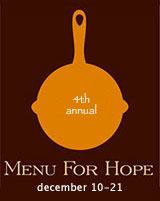 For two weeks every December, food bloggers from all over the world offer a delectable array of food-related prizes for the Menu for Hope raffle. Last year, we raised $62,925 to help the UN World Food Programme feed the hungry. This year’s campaign runs December 10 to 21. Every $10 donated earns you one virtual raffle ticket for the prize of your choice.
For two weeks every December, food bloggers from all over the world offer a delectable array of food-related prizes for the Menu for Hope raffle. Last year, we raised $62,925 to help the UN World Food Programme feed the hungry. This year’s campaign runs December 10 to 21. Every $10 donated earns you one virtual raffle ticket for the prize of your choice.
(To learn more, read the Menu for Hope IV FAQ.)
If you’re interested in winning one of the fabulous prizes we’re offering here on Married… with Dinner — the Ferry Building gift basket, the Drink of the Week photocards, or the custom mixology service — here’s how to enter:
- Check out the other cool items available on Rasa Malaysia and Chez Pim. (We know you want OUR prize, but you might want to bid on others, too …you generous foodie, you.)
- Go to the donation page for Menu for Hope IV. Just like last year, funds raised will go to support the United Nations World Food Programme.
- Make a donation! Each $10 pledge will give you one virtual raffle ticket toward a prize of your choice. Please specify which prize or prizes you’d like in the “Personal Message” section in the donation form when confirming your donation.
- Don’t forget to mention how many tickets you want to allot per prize, and please use the prize code — for example, a donation of $50 can buy 1 ticket for UW-06, 1 for UW-07, and 3 for UW-08.
- If your company matches your charity donations, please remember to check the appropriate box on your submission and fill in the information so Menu for Hope can claim the corporate match.
- Please also check the box that allows the contest administrators to see your email address so that they can contact you in case you win. Your email address will not be shared with anyone else.
- Check back on Chez Pim
at the end of the month on January 9, when Pim will announce the result of the entire raffle. (We’ll also announce the winner of our prizes here.)
Good luck to everyone, and thanks for supporting such a worthy cause!
Menu for Hope
Comments Off on Menu for Hope IV




Posted by Anita on 12.10.07 12:03 AM
 Custom Mixology Service
Custom Mixology Service
The “cocktail geeks” from Married… with Dinner will create a pair of personalized beverages for your soiree, based on your preferences. We’ll do all the prep beforehand, then serve your signature selections to up to 12 of your closest friends.
We’ll provide all the necessaries: Ice, mixers, syrups, garnishes, plus any tools we’ll need. We’ll even bring suitable glassware: No cocktail cleanup!
(Please note: We’re happy to shop and schlep, but due to liability issues, the winner must pay for the alcohol.) This prize is limited to San Francisco Bay Area redemption — unless you’d like to pay travel expenses… let’s talk! — and is subject to a mutually convenient schedule.
This item is Menu for Hope prize UW-08.
– Click here to make a donation and enter to win.
– Read the Menu for Hope overview to learn more.
drinks, entertaining, Menu for Hope
Comments Off on Menu for Hope: Prize #3




Posted by Anita on 12.10.07 12:02 AM
 “Drink of the Week” Cocktail Notecards
“Drink of the Week” Cocktail Notecards
Be the envy of your cocktailian friends with this one-of-a-kind set of photo-postcards featuring images from Married… with Dinner’s popular “Drink of the Week” series.
These cards feature 20 different images selected from the best examples of more than a year’s worth of tempting photos, including a number of award-winning images. Use them for thank-you notes and party invitations, or hang them in your home bar for inspiration. This set of postcards is professionally printed by Moo — the same folks who make those miniature calling cards that all the bloggers love. They’re printed on heavyweight cardstock and laminated on the front, with a final size of approximately 4×6 inches.
Worldwide shipping is available for this prize.
This item is Menu for Hope prize UW-07.
– Click here to make a donation and enter to win.
– Read the Menu for Hope overview to learn more.
Drink of the Week, Menu for Hope
1 Comment »




Posted by Anita on 12.10.07 12:01 AM
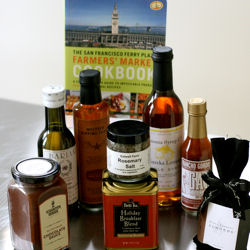 “Best of the Ferry Building” Gift Basket
“Best of the Ferry Building” Gift Basket
An assortment of more than $100 worth of treats from San Francisco’s legendary Ferry Building Marketplace: Peet’s holiday blend breakfast tea, Scharffen Berger chocolate sauce, Recchiuti burnt caramel almonds, Bariani olive oil, Rancho Gordo hot sauce, Prather Ranch marinade, Eatwell Farm rosemary salt, lemon-infused Sonoma Syrup. You’ll also receive a copy of the popular Ferry Plaza Farmers Market Cookbook.
To give you something to remember us by when all the goodies are gone, this prize also includes the winner’s choice of an 8×10 print from our collection of market photos.
International bids are welcome, but winners outside the Continental US will be asked to pay for any shipping fees over our US$25 limit.
This item is Menu for Hope prize UW-06.
– Click here to make a donation and enter to win.
– Read the Menu for Hope overview to learn more.
farmers markets, Menu for Hope
1 Comment »




Posted by Anita on 12.07.07 7:03 AM
 After going to all that trouble to find our favorite sweet vermouths, it seems only fitting for this week’s drink to highlight vermouth’s strengths. So many recipes that call for sweet vermouth use just a splash, or drown its subtleties under a lot of strong liquor. But the Americano — essentially a highball Negroni, minus the gin — takes advantage of both vermouth’s sweetness as a foil and its bitterness as a complement to the drink’s other main ingredient: Campari.
After going to all that trouble to find our favorite sweet vermouths, it seems only fitting for this week’s drink to highlight vermouth’s strengths. So many recipes that call for sweet vermouth use just a splash, or drown its subtleties under a lot of strong liquor. But the Americano — essentially a highball Negroni, minus the gin — takes advantage of both vermouth’s sweetness as a foil and its bitterness as a complement to the drink’s other main ingredient: Campari.
Not surprisingly, Campari’s distinctively bitter bite pairs best with a less-herbal sweet vermouth. (Monseiur Prat, your services will not be required this evening.) Most recipes call for a 1:1 ratio of Campari to sweet vermouth, but I like my Americanos — and my Negronis, for that matter — on the wetter side. Especially when using a specialty brand like Carpano Antica, this slight imbalance helps the vermouth emerge from Campari’s assertive shadow. This is definitely one of those times to use the Cinzano, if you have it. Its sweetness isn’t as problematic here, and actually helps balance the bitterness.
A tall, cool drink may seem an odd choice for December, but consider its merits: The color’s a festive red, and the flavor’s sassy enough to hold its own alongside rich holiday hors d’oeuvres. With seltzer’s sparkle and a relatively low alcohol content, the Americano makes a savvy choice in a season that’s often filled with back-to-back parties. There aren’t any tricky measurements to remember, and the Americano’s strength is infinitely adaptable to the drinker’s taste simply by adjusting the spirit-to-soda ratio. In short, it’s the platonic cocktail-party option, a seasonal spritzer extraordinaire.





Americano
1 oz sweet vermouth
3/4 oz Campari
soda water
lemon twist (optional)
Add the vermouth and Campari to an ice-filled highball or rocks glass. Top with soda water and stir to combine. Garnish with a lemon twist, if desired.
Drink of the Week, drinks, recipes
4 Comments »




Posted by Anita on 12.06.07 6:19 PM
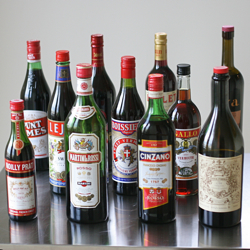 Restocking the bar in preparation for holiday guests, we found we’d managed to squirrel away no less than four half-empty bottles of sweet vermouth. Shaking our heads at our folly, we decided to figure out which one we liked best and toss the others. Sure, we needed Carpano Antica for our favorite cold-weather Manhattan, but how different could the others be?
Restocking the bar in preparation for holiday guests, we found we’d managed to squirrel away no less than four half-empty bottles of sweet vermouth. Shaking our heads at our folly, we decided to figure out which one we liked best and toss the others. Sure, we needed Carpano Antica for our favorite cold-weather Manhattan, but how different could the others be?
Plenty.
After some quick sips, it became apparent that even among the big three brands — Cinzano, Noilly Pratt, and Martini & Rossi — the differences were astounding. The lone French-made bottle, the Noilly Pratt was the most herbal, and most bitter, of the three …a potent reminder of vermouth’s linguistic origins in “wormwood”. The original sweet vermouths came from Italy — you’ll often see red vermouth referred to as Italian vermouth in old recipes — so it’s not surprising that we felt the Martini and Cinzano brands were closer to our ideal. (Some day we’ll have to check whether the reverse is true: Do the French make better dry vermouth, given its historic roots on the other side of the Alps?)
On our next trip to the liquor warehouse, our eyes were opened. We’d never noticed just how many sweet vermouths were on the shelf! With most bottles priced well under $10, why not round out our collection and get to the bottom of which was best? My sister and her husband were on their way to town, and a sweet vermouth tasting seemed just the ticket for four cocktail aficionados to while away the holiday weekend.
With a stack of shot glasses and a pile of notepads at the ready, the tastings began.
Our first round featured the supermarket stalwarts: Martini & Rossi, Cinzano, and Noilly Pratt (identically priced around town at $5.99 to $7.25). Just as we’d found in our earlier un-juried tasting, the Noilly Prat stood out from the pack: Its “herbal” “bite” was pegged as “very bitter” and “medicinal” by all. Tasted neat, Cinzano’s sweetness was its downfall: We called it “cloying candy” and “marshmallow sweet”, overwhelming its less obvious “citrus and spice” notes. The Martini & Rossi became the bottle to beat, universally praised for its “smooth”, “balanced”, “fruity warmth”.
The lesser-known vermouths in our next tier proved that you mostly get what you pay for. Although the Boissiere ($7.29) was dubbed “not bad” by three tasters, the Gallo ($2.99) rated “foul”, “bad”, and “not pleasant” across the board. The true stinker was Lejon ($3.99), which sent us running for our water glasses: Strong “vinegar” notes and “artificial” flavors earned it a last-place finish: “Blech!” indeed.
Next up, a pair of boutique options. At $29, Carpano Antica’s the priciest of the lot, but it’s a house favorite for good reason. Its “very smooth” profile was noticeably more “spicy and deep” than its mainstream competitors. All of us noted its sweetness, but felt it offered a “chewy”, “caramel” complexity rather than a brash sugar assault. Our local entrant, Vya ($19) showed its “grapey” pedigree — it’s made by Quady, the winery behind the once-trendy Elysium black muscat. With “piney” hints of “juniper” and a “snappy” finish, one taster found it a bit too “menthol” for his palate.
We also tasted a flight of red-wine based aperitifs: The French-made Lillet Rouge and Dubonnet, and the Italian Punt e Mes. Too far off the beaten path to serve as straight replacements for sweet vermouth, they’re more like kissing cousins than actual alternatives. Lillet and Dubonnet were pleasant enough to drink on their own; Punt e Mes found few fans due to its very strong bitterness, although it’s a key ingredient in a handful of cocktails.
As a control, we stirred up a set of Manhattans to see if the differences between brands were too subtle to be noticed in mixed drinks. All of us agreed that the Carpano’s complexity shone through the iced-down whiskey to make a worthy upgrade. Of the non-boutique brands, the gents were aligned in their preference for Martini in their Manhattans. Meanwhile, I preferred the Cinzano — its sweetness isn’t such an issue when whiskey’s there to tame it — and my sister enjoyed both Italian vermouths equally. The Noilly Prat’s herbal tones were a little less obnoxious when mixed and chilled, but none of us cared for its flavor.
Our Manhattan-loving brother felt strongly that the only ‘proper’ drink of the bunch was the Martini & Rossi version. He allowed that the Carpano variation was lovely, “just not a Manhattan.” The dark-horse Boissiere Manhattan was deemed an acceptable option; if for some reason you find yourself in possession of a bottle, keep it… but none of us would recommend hunting it down for special purchase.
So which sweet vermouth should you buy? The Carpano Antica is our hands-down favorite for Manhattans, but it’s a pricey (and potentially unnecessary) option in many other drinks. If you’re limiting yourself to one all-purpose bottle, the Martini & Rossi does quite well. The Cinzano’s added depth makes it a natural in drinks with a strong bitter or sour component to counter its sweetness, but it’s a less-than-ideal pairing with other sugared liquors or syrups. Both are affordable enough that, if your space allows, there’s no reason to choose between the two big Italians.
Speaking of storage: Many wise folks will tell you to keep your vermouth in the fridge, and they’re right. It’s wine, after all, and vermouth can turn from ambrosial to undrinkable when improperly handled. Spoilage takes a bit longer with vermouth than table wine, courtesy of the former’s higher alcohol content, but even a fortified wine will eventually turn. Do yourself a favor and choose 375ml half-bottles when you find them — tossing half an oxidized bottle undoes any potential savings you’d see by buying the 750ml size — and keep the vermouths you really care about in cold storage as much as you practically can.



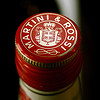

drinks
9 Comments »




Posted by Anita on 12.05.07 12:07 PM
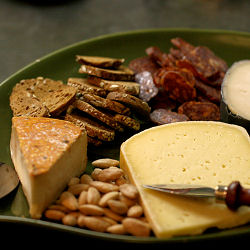 Thank goodness, we’re done with turkey. Blissfully, all of the bits and pieces made their way either into our bellies or the stock pot by early last week.
Thank goodness, we’re done with turkey. Blissfully, all of the bits and pieces made their way either into our bellies or the stock pot by early last week.
On Sunday night, we were so sick of overstuffed plates that we decided to graze. The platter pictured was our family supper: Fra’Mani salumi, Judy’s country crackers, Alfieri’s salted blanched almonds, and three cheeses: Gravenstein Gold, Matos St. George, and Midnight Moon. Every last bit was local, and all of it was delicious.
(For the play-by-play on turkey sandwiches and last week’s other local meals, check out the Flickr set.)
Of course, there’s no getting through Thanksgiving leftovers in our house without the obligatory platter of Enchiladas Suizas. This tangy south-of-the-border specialty is my favorite way to use up excess poultry, no matter the season. But my attempts to keep the dish 90% local highlighted one of the realities of the Dark Days challenge: It’s getting harder to eat as we like as the year wanes.
Unable to find tomatillos at the Ferry Plaza market, I hit up Rainbow Grocery… but theirs hailed from Mexico. I did turn up a few small specimens at the Berkeley farmers market, but they weren’t exactly plentiful. Next year, I’ll follow the lead of the Monkey Wrangler and put up tomatillos when they’re overflowing the market stalls.
But no matter the shopping conundrum, there are few things that make me happier than sitting with my clan around a table full of gorgeous Mexican comfort food. We rounded out the meal with a pan of sopa seca (Mexican rice) and a pot of heirloom beans. We even managed a small bowl of guacamole courtesy of our friend Tea, who gifted us with a trio of the season’s last avocados on her way out of town.
It’s becoming clear that locavore meals are going to require additional creativity in the coming weeks. (Is it cheating to call dried chiles a spice when you’re using them by the bagful to make enchilada sauce? Hmm…) Thankfully, we’ll be able to get our Lundberg rice and our Rancho Gordo tortillas and beans year-round. In the meantime, Rick Bayless assures us that his recipe’s just as good with canned red tomatoes as it is with fresh tomatillos; it might just be the sort of project worth a dip into our pantry stash.


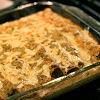


Enchiladas Suizas
– adapted from Mexico One Plate at a Time
3 pounds tomatillos, husks removed, washed to remove sticky residue
– or substitute two 28-oz cans whole tomatoes, drained
2 serrano or jalapeño chiles, stemmed
2T pork fat, chicken fat, or oil
1 medium onion, chopped
2 cups chicken or turkey broth
1/2 cup sour cream, thinned with 2T cream or milk
3 cups shredded meat, such as leftover roast chicken or turkey
2/3 cup shredded melting cheese, such as Jack
12 corn tortillas
For garnish: sliced purple onions, cilantro springs, radish slices
Roast the tomatillos and chiles under the broiler until charred and soft on both sides. Transfer to a blender along with the pan juices and puree until no large pieces remain. (If using canned tomatoes, roast the chiles in a skillet, blend them with the drained tomatoes, and proceed.)
Heat the oven to 350°F.
In a Dutch oven, heat the pork fat over medium heat. Add the onion and saute until golden. Raise the heat a notch and add the puree; cook until thickened to the consistency of porridge, 10 to 15 minutes. Stir in the broth and season to taste with salt. Cover partially and simmer 15 minutes until the sauce is still slightly soupy. Keep warm until ready to use, thinning with more broth or water as needed to keep relatively loose.

Just before using, stir the thinned sour cream into the sauce. In a large bowl, combine the meat with about 1/2 cup of the sauce, or enough to coat it without making too wet. Season to taste.
Lay the tortillas out on two baking sheets, and brush lightly both sides with corn or vegetable oil (or more pork fat). Heat in the oven for about 3 minutes, until tortillas soften enough to roll without breaking. Remove from oven and keep warm, wrapped in a towel.
Spread 1 cup of the sauce on the bottom of a 13 x 9 pan. Roll up a portion of the chicken mixture in each tortilla, then arrange the filled enchiladas in the pan in a single layer. Cover with the remaining sauce, then top with the cheese. Bake until the dish is heated through, about 15 minutes. (Depending on your oven, you may need to cover the top to prevent overbrowning, or turn on the broiler at the end to give the cheese a golden crisp.)
Serve, 2 or 3 to a plate, garnished with onion slices, radishes, and/or cilantro sprigs.
Note: Leftovers are delicious, but because the tortillas lose their shape and consistency, it’s more like a casserole on the second day.
cooking, family, locavore, Mexican, recipes
1 Comment »




 For two weeks every December, food bloggers from all over the world offer a delectable array of food-related prizes for the Menu for Hope raffle. Last year, we raised $62,925 to help the UN World Food Programme feed the hungry. This year’s campaign runs December 10 to 21. Every $10 donated earns you one virtual raffle ticket for the prize of your choice.
For two weeks every December, food bloggers from all over the world offer a delectable array of food-related prizes for the Menu for Hope raffle. Last year, we raised $62,925 to help the UN World Food Programme feed the hungry. This year’s campaign runs December 10 to 21. Every $10 donated earns you one virtual raffle ticket for the prize of your choice.



 Custom Mixology Service
Custom Mixology Service “Drink of the Week” Cocktail Notecards
“Drink of the Week” Cocktail Notecards “Best of the Ferry Building” Gift Basket
“Best of the Ferry Building” Gift Basket

















